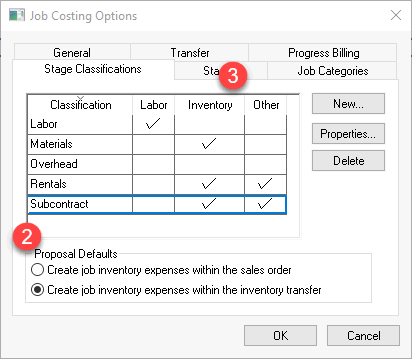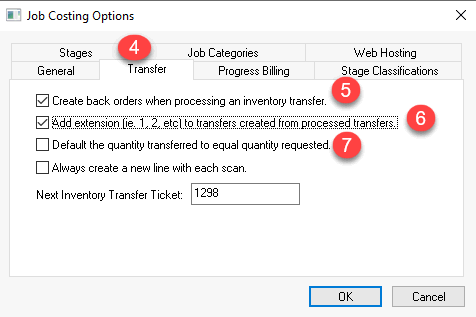Job Materials Overview
Does the company create a materials list for individual projects? A materials list may include materials, subcontract labor, and other costs such as rentals and supplies. This materials list may be used to quote within EBMS or may be exported from an integrated quoting software. A materials list can be used to generate a request for quote (RFQ) document sent to various vendors for pricing.
Purchase orders are created from the Job Transfer when materials are ordered from the suppliers. These purchase orders may include materials, subcontract labor, rental expenses, and other supplies purchased for a specific job. An expense invoice is processed with the job expenses are purchased and delivered.
The available methods to create a materials list for a job:
-
Create a list of materials within the proposal dialog
-
Import a list of materials from a design software
-
Add materials manually to an inventory transfer
Scenario: A construction company creates job proposals using the EBMS quoting system. These quotes contain various materials, project labor, as well as calculated pricing from the square footage of roofing and siding. Job proposals also double as a job budget. Much of the job transfer list is created from the product items entered in the proposal. Some transfer lines consist of a single subcontract value for the roofing, siding, plumbing, electrical, and flooring costs for the project . This process allows the EBMS user to send request-for-quote (RFQ) documents to vendors to quote the project. Purchase orders are then created from the job transfer when a contract is signed by the vendor or supplier.
Scenario: A custom equipment manufacturing company creates a materials list within the proposal screen of EBMS to create a quote for the customer. The cost and pricing of the parts, components, and manufacturing costs are compiled to create a contract quote for the project. The costs of the parts, assemblies, subcontract services, and other projected costs become a budget for the manufacturing job. The job transfer process within EBMS gives the manufacturer the ability to quote, budget, create request for quote (RFQ), and create purchase orders from this materials list.
Scenario: An exterior home improvement company quotes a project based on the square footage of the siding or roofing as well as the actual cost of doors, windows, and other mechanical products. The salesperson creates a quote based on pricing formulas rather than a complete materials list. The project manager creates a materials list within the Inventory Transfer dialog for each stage of the project.
Review the following important guidelines to create and process materials and inventory in job costing:
-
Open the following options by selecting Job Costing > Options from the main EBMS menu.
-
Verify that the Create job inventory expenses within the inventory transfer option is selected as shown below:

-
All stages that contain materials must be classified with the Inventory option enabled as shown above.
-
Click on the Transfer tab of the options dialog. Set the following job costing settings:

-
Enable Create back orders when processing an inventory transfer. This option will enable the user to post materials and inventory costs into jobs at different times.
-
Enable Add Extension (ie.1.2 etc) to transfers created from processed transfers to clearly group all transfers that were created from a common proposal.
-
Disable Default the quantity transferred to equal quantity requested since the inventory transfer dialog is used to create purchase orders for individual lines.
-
Use the proposal dialog to create a materials list within a quote and then create an Inventory Transfer Ticket. Review Materials List within a Proposal for detailed steps.
-
Review Material Purchase Orders for instructions on creating purchase orders for special ordered materials for a job.

